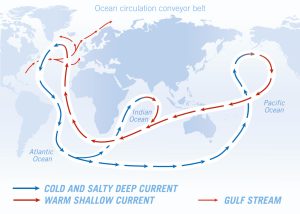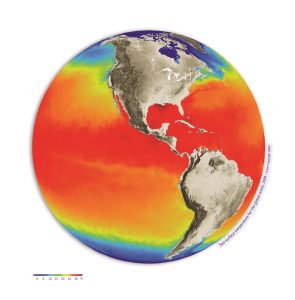Highways of the Oceans – Sea currents and the connection to climate
In this set of three activities, students will use an multimedia module to learn about sea currents, the highways of the oceans, and how they are important for understanding local climates. Using a hands on activity they will investigate what causes ocean currents. They will also use satellite images to analyse the temperature of the sea surface and understand why satellite observations are useful for monitoring sea currents.
Subject Geography, Science, Physics
- Elaborate on global ocean and air currents and discuss what they mean to the climate
- Identify local and global weather processes and climatic phenomena and their causes
- Use tools available on the internet to collect and analyse satellite data
- Understand how Earth observation can be used to monitor oceans
- Interpret sea surface temperature maps


- Two 250ml beakers
- Coloured ice cubes
- 1 teaspoon
- Salt
- Water

Did you know?
To measure the sea surface temperature, satellites register different types of light that we cannot see with our eyes. One of these special types of light (or radiation) is called thermal infrared. It is the same radiation registered by night vision cameras. The infrared sensor from the Sentinel-3 satellite provides precise global maps of sea surface temperature. This information is used to monitor oceans and climate change, as well as for weather forecasting.

Paxi – The Greenhouse effect
Brief description:Join Paxi as he explores the greenhouse effect to learn about global warming. In this video, targeted at children...
Paxi – The Water cycle
Brief description: Join Paxi as he visits Planet Earth, and learn about the water cycle. In this video, targeted at...
One year on Earth – Understanding seasons
Brief description This resource includes two activities to foster and enhance pupils’ knowledge of seasons, and focuses on the basic...
A Passage opens – Arctic sea ice and climate change
Brief description In this set of three activities, students will discover the important role Arctic sea ice plays in the...


